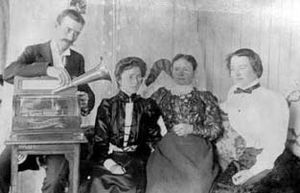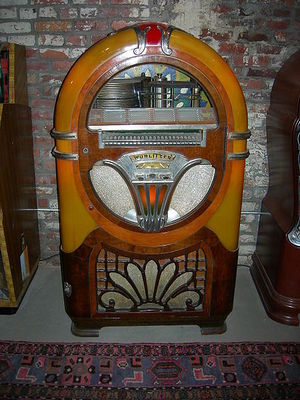Jukebox: Difference between revisions
No edit summary |
No edit summary |
||
| (7 intermediate revisions by 2 users not shown) | |||
| Line 1: | Line 1: | ||
== Jukebox History == | == Jukebox History == | ||
[[Image:Jukebox.jpg|right | <p>[[Image:Jukebox.jpg|thumb|right]] </p> | ||
[[Image:Midcentury_24-disc_Wurlitzer_jukebox.jpg|thumb|right|24-disc Wurlitzer jukebox. Photo by Joe Mabel]] | |||
<p>When [[Thomas Alva Edison|Thomas Edison]] invented the [[Phonograph|phonograph]] in 1877 he thought one of its uses would be as a voice recorder for office [[Dictation Machines|dictation]]. Its use for entertainment proved to be much more popular, however, and others quickly looked for ways to cash in on this phenomenon. </p> | |||
[[ | <p>In 1890, one clever entrepreneur modified the phonograph to be coin-operated and provided multiple listening tubes (this was in the days before the phonograph featured a [[Loudspeakers|loudspeaking horn]]). The use of these early coin-in-the-slot phonographs encouraged people to buy their own phonographs for home entertainment. Coin-operated phonographs continued to be built in later years, but they did not gain much popularity. Then, with the coming of radio in the 1920s, the record industry nearly disappeared and it looked like the jukebox would go with it. </p> | ||
The | <p>The revival of the record industry took many years. In the 1930s, the Great Depression actually helped the record industry, since more people were looking for inexpensive forms of entertainment. By about 1939, sales of records for use in jukeboxes was a large percentage of total record sales. Soon, listening to records on the jukebox became a fad, stimulating even greater sales of records. By 1940, jukeboxes made by Wurlitzer, American Musical Instruments (AMI), and Rock-O-La could be found in almost every restaurant and bar across the country. </p> | ||
=== Jukebox Controversy === | |||
[[Category:Culture_and_society]] [[Category:Leisure]] [[Category:Music]] | <p>The jukebox was sometimes the center of controversy. Parents, concerned by the popularity of swing and Jazz music, thought the machines were a bad influence on their children. The association of the jukebox with bars gave it a somewhat seedy reputation—the term juke joint used to refer to a dive or a low-class bar. The questionable reputation of the jukebox got even blacker when scandal erupted in the New York area after it was discovered that the Mafia controlled the operation of jukeboxes throughout the area. Nevertheless, jukebox listening continued to provide entertainment through the war years. </p> | ||
<p>The 1940s and 1950s are considered the heyday of the jukebox, when listening was at an all-time high. The machines made in these years were elaborate and flashy—in fact the jukeboxes of the 1950s had chrome grills and tailfins like cars. These machines were made to last almost forever, but the coming of the [[LP and 45 RPM Records|45-rpm record]] in 1948 banished the beautiful jukeboxes of the 30s and 40s to the junkyard. Today they are prized by collectors. As the life span of the 45-rpm record began to slow in the 1980s, it was the jukebox that kept the 45 alive for a few more years. But jukebox manufacturers began to switch to [[Compact Discs (CDs)|CDs]] in recent years, and the old machines are rarely seen outside private collections today. </p> | |||
[[Category:Culture_and_society]] | |||
[[Category:Leisure]] | |||
[[Category:Music]] | |||
[[Category:News]] | |||
Revision as of 14:30, 2 February 2012
Jukebox History
When Thomas Edison invented the phonograph in 1877 he thought one of its uses would be as a voice recorder for office dictation. Its use for entertainment proved to be much more popular, however, and others quickly looked for ways to cash in on this phenomenon.
In 1890, one clever entrepreneur modified the phonograph to be coin-operated and provided multiple listening tubes (this was in the days before the phonograph featured a loudspeaking horn). The use of these early coin-in-the-slot phonographs encouraged people to buy their own phonographs for home entertainment. Coin-operated phonographs continued to be built in later years, but they did not gain much popularity. Then, with the coming of radio in the 1920s, the record industry nearly disappeared and it looked like the jukebox would go with it.
The revival of the record industry took many years. In the 1930s, the Great Depression actually helped the record industry, since more people were looking for inexpensive forms of entertainment. By about 1939, sales of records for use in jukeboxes was a large percentage of total record sales. Soon, listening to records on the jukebox became a fad, stimulating even greater sales of records. By 1940, jukeboxes made by Wurlitzer, American Musical Instruments (AMI), and Rock-O-La could be found in almost every restaurant and bar across the country.
Jukebox Controversy
The jukebox was sometimes the center of controversy. Parents, concerned by the popularity of swing and Jazz music, thought the machines were a bad influence on their children. The association of the jukebox with bars gave it a somewhat seedy reputation—the term juke joint used to refer to a dive or a low-class bar. The questionable reputation of the jukebox got even blacker when scandal erupted in the New York area after it was discovered that the Mafia controlled the operation of jukeboxes throughout the area. Nevertheless, jukebox listening continued to provide entertainment through the war years.
The 1940s and 1950s are considered the heyday of the jukebox, when listening was at an all-time high. The machines made in these years were elaborate and flashy—in fact the jukeboxes of the 1950s had chrome grills and tailfins like cars. These machines were made to last almost forever, but the coming of the 45-rpm record in 1948 banished the beautiful jukeboxes of the 30s and 40s to the junkyard. Today they are prized by collectors. As the life span of the 45-rpm record began to slow in the 1980s, it was the jukebox that kept the 45 alive for a few more years. But jukebox manufacturers began to switch to CDs in recent years, and the old machines are rarely seen outside private collections today.

